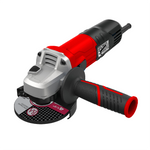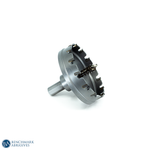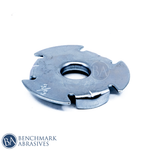
How Does The Hardness Of A Material Influence The Choice Of Abrasive?

The link between the hardness of a workpiece and the type of abrasive used is critical for shaping, cutting, or finishing materials. In simple terms, a basic yet essential principle defines how effective any abrasive procedure is: the abrasive must be capable of withstanding the resistance of the material being processed.
In other words, the abrasive should be hard enough to cut or eliminate material from the workpiece efficiently. This basic principle states that, usually, a harder workpiece requires a harder abrasive. Although it's important to keep in mind that this is not the only factor to consider, other material properties, as well as application requirements, also affect the selection of final abrasives.
THE SIGNIFICANCE OF HARDNESS
Hardness is important in abrasive operations as it directly affects the material's ability to endure constant deformation, particularly scratches or dents. The following are the reasons why it's so crucial while selecting abrasives:
-
Effective Material Removal
The degree of hardness between the material and the abrasive defines the degree of material that is supposed to be eliminated. By design, abrasives should be harder than the materials being worked on. This advantage in hardness enables the abrasive grains to cut, shear, or abrade the surface of a workpiece, eliminating material in chips or dust.
Softer abrasives, on the other hand, will simply be worn away by the workpiece, which results in excessive wear, ineffective cutting, and eventually, the failure to get the required material removal. Hence, choosing an abrasive with the right hardness is crucial for increasing material removal rates and for getting the required surface finish.
-
Preventing Damage
Choosing the correct hardness is essential to prevent damage during abrasive operations. Applying an abrasive that is harder than the workpiece can cause uncontrolled material removal, which further leads to scratches, gouges, or even structural damage, especially on softer materials.
Also, the softer abrasives will not work on hard materials, which results in minimal material removal and burnishing or surface glazing. Aligning the hardness of the abrasive to the workpiece guarantees controlled material removal, protecting the integrity of the surface along with avoiding unwanted flaws.
-
Optimizing Performance
Optimizing performance in abrasive applications is directly linked to aligning abrasive hardness to the workpiece. This thorough selection will result in boosted efficiency, better surface finish, and quicker rates of material removal. A carefully chosen abrasive minimizes wear, which helps in increasing its durability and decreases overall operating expenses. The procedure becomes more accurate, reliable, and economical by making sure the abrasive can cut efficiently without using too much effort or wearing down, which eventually maximizes the intended result.
-
Surface Profile Control
Abrasive hardness is directly linked to the surface profile that is formed on the workpiece. When applied correctly, harder bonded abrasives will cut more deeply into the workpiece and eventually create a deeper surface profile. This is extremely crucial in operations where coatings will be applied to the workpiece.
-
Abrasive Wear
The proportional hardness of the material you are working with and the abrasive itself often determine abrasive wear. Appropriate hardness alignment will increase the abrasive lifespan.
MOHS SCALE OF HARDNESS
Friedrich Mohs developed the Mohs Hardness Scale, a vital tool for grouping minerals based on how resistant they are to scratches. This ordinal scale starts from 1 (talc) to 10 (diamond) , and offers a relative measure of hardness that shows the capacity of one mineral to scratch another. It's essential to understand that the scale is not linear, which means that the different numbers do not correspond to equal increments in hardness.
This scale is highly beneficial for field geologists and mineralogists, as it helps them by allowing quick identification via scratch tests. Although the Mohs scale is also helpful for minerals, it has a few limitations when used in industrial materials, including metals or ceramics, wherein more accurate readings from tests such as Vickers or Rockwell are required. Apart from these limitations, the Mohs scale is still an invaluable tool in mineralogy providing a practical and approachable way for determining a material's scratch resistance.
THE IMPACT OF HARDNESS ON ABRASIVE SELECTION
The hardness of the material directly determines the selection of an adequate abrasive that affects the efficiency and effectiveness of any grinding, cutting, or polishing procedure.
-
Hard Materials
To remove Hard materials like hardened steels, ceramics, and carbides, very hard abrasives are required. Diamond and cubic boron nitride (CBN) are frequently necessary due to their exceptional hardness and capacity to retain sharpness under extreme strain. Silicon carbide and ceramic abrasives provide effective cutting action and excellent wear resistance, accordingly. When dealing with these difficult materials, choosing these specialized abrasives is vital to ensure effective material removal, accurate shaping, and extended tool life.
-
Medium-Hard Materials
Dealing with medium-hard materials, including steel, cast iron, or hard plastics, enables a wide range of abrasive choices. Aluminum oxide is a popular and adaptable option that offers effective grinding and finishing. Another perfect option is garnet, which is typically used in applications including sandblasting and general surface preparation. The selection method aims for efficiency and cost-effectiveness by balancing surface finish criteria with material removal rates. These abrasives are perfect for a variety of industrial applications because they provide a reasonable balance between cost and hardness.
-
Soft Materials
Soft materials like aluminum, brass, or wood need abrasives that are less aggressive to avoid damage and to get a smooth finish. Sand is a popular option for light cleaning and surface preparation, whereas finer grit abrasives are mainly used for polishing and more delicate tasks. The main goals are to avoid excessive scratching or gouging and to control material removal. To maintain the integrity of the softer workpiece, these abrasives are chosen to offer a balance between tenderness and efficacy.
ADDITIONAL FACTORS BEYOND HARDNESS
Although hardness is a major factor in abrasive selection, it's not the only determinant. Several other factors are vital in optimizing the abrasive process, which include:
-
Material Type: The specific material type of the workpiece affects how the abrasive interacts with it, as various materials respond differently to abrasive action.
-
Desired Finish: The grit size and abrasive type are determined by the intended surface finish, which might be either a smooth, polished surface or a rough profile for adherence.
-
Applications: The application includes cutting, grinding, or polishing, which determines the abrasive shape and cutting action.
-
Cost: Another important consideration is cost, which weighs economic viability against performance.
Hence, aligning the abrasive hardness to the workpiece hardness is important for effective and efficient material removal.



































































